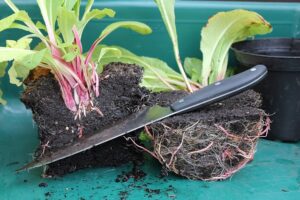Have you ever wanted to turn one plant into two—or twenty? When it comes to gardening, propagation is the magic trick that lets you do just that. It’s the gift that keeps on giving – quite literally! Whether you’re a homesteader looking to expand your vegetable patch, a plant enthusiast dreaming of growing new life, or a permaculture devotee aiming for sustainability, this guide to plant propagation techniques will help you level up your propagation game. Stick with me, and soon you’ll be the proud parent of an entire plant family.
Let’s dig into the “how-to”s below, covering everything from collecting seeds to… (wait for it)… tissue culture. Don’t worry. I’ll break it all down!
I. Sexual Propagation Methods
A. Seed Collection and Storage
Ever looked at a ripe tomato or a dried flower and thought, “Hmm, could I grow this again?” The answer is yes! But step away from the tomato juice—there’s a method to this madness. Seed propagation starts with identifying mature seeds (pro tip: they’ll usually be dark, firm, and dry). Timing is key here. Collect seeds when the parent plant is at its peak maturity.
Store seeds somewhere cool, dry, and dark to ensure they stay viable. Think mason jars in your pantry (aka your plant HQ).
B. Seed Treatment Techniques
Some seeds are ready to sprout with just a bit of moisture. Others? They’re divas, and they demand special treatment. Scarification (careful scratching) wears away their tough exterior; stratification mimics a winter chill to coax them awake; and pre-soaking softens them up. Then there’s smoke water treatment for smoky divas—mimicking wildfires to trigger germination (yes, seriously).
C. Sowing Methods
Once your seeds are prepped and raring to go, it’s time to plant. You can sow directly into the soil or start off in containers. The key is understanding how deep to plant them (hint: they like the comfort of their seed size’s depth). Baby them like you would a soufflé; they need the right environment to rise.
II. Vegetative Propagation
If seeds sound like too much fuss, don’t plant yourself in despair! Vegetative propagation (aka, cloning your plants) is SO satisfying.
A. Cutting Techniques
Cuttings are your shortcut to multiplying your garden faves—and they come in a variety pack.
- Softwood cuttings come from young stems (think spring vibes).
- Hardwood cuttings are from mature branches (hello, winter).
Snip strategically, mind those nodes, and place them in water or soil. It’s like magic—but with a bit of chlorophyll.
B. Division Methods
Splitting plants is just like dividing a pizza—everyone gets a share! Crown division works wonders for clumping plants like hostas, while bulb division keeps things growing year after year. Just be gentle… plants don’t appreciate being yanked around, thank you very much.
C. Layering Techniques
Layering might just be one of the coolest propagation hacks—no scissors required! With techniques like air layering (wrapping a stem to grow roots mid-air) or mound layering (burying parts of a plant to root in soil), plants practically do the work for you. Lazy gardener-approved.
III. Grafting and Budding
For garden overachievers (yes, I see you), grafting and budding take propagating to premium levels.
A. Grafting Fundamentals
Ever seen an apple tree bearing five different apple varieties? The secret lies in grafting, where rootstocks meet scions to form a plant partnership. It’s like matchmaking for trees.
B. Budding Techniques
Budding (think T-budding or chip budding) is honestly adorable. Tiny buds are inserted into rootstock, given a bit of time, and voila—a new plant!
IV. Tissue Culture Basics
This one’s for the science geeks and plant lovers who dream BIG. Tissue culture isn’t just propagation, it’s plants on steroids. By working with plant cells in a sterile lab, you can create tons of identical plants, free of disease. Plus, it sounds really fancy when you casually drop “suspension culture” into conversation.
- Tip: Just don’t try this one on your dining table. A sterile lab environment is a must.
V. Environmental Control and Management
Think propagation ends with planting? Oh no, friend. Plants are divas. They demand just the right amount of light, humidity, and ventilation. And don’t even get me started on pest management! A single aphid can wreck everything. (All hail neem oil, the gardener’s trusty shield.)
VI. Propagation Infrastructure
Building out a propagation station doesn’t require loads of cash (or a construction crew). Greenhouses, mist systems, and cold frames are great to start with, but for the minimalist gardener, a sunny windowsill equipped with a few propagation trays works wonders.
VII. Care and Maintenance
Post-propagation care is crucial to nurturing your new plant babies. Hardening off prevents transplant shock (plants don’t like sudden change—sound familiar?) and watching for seasonal pests keeps them thriving through the year.
VIII. Keep Track of Your Progress
Not all experiments will yield instant success. That’s alright—every set-back is a lesson. Taking notes on what worked, what didn’t, and how those plants are faring will make you a propagation pro in no time.
IX. Troubleshooting Common Problems
Root rot ruining your mood? Cuttings refusing to root for you? (Sorry, couldn’t resist the pun.) There’s always a solution. Just step back, diagnose, and try again. Plants love patience.
X. The Business of Propagation
Love propagation so much you want to make it profitable? Start a small-scale plant nursery, explore rare plant markets, or offer grafted trees for sale—this skill pays off. Literally.
Check out resources for budding propagators (pun intended again—last time, promise): books, networks, learning hubs—you name it. Because there’s always something new to learn in the garden world.
Final Thoughts
Plant propagation combines science, art, and a bit of gardening guts. It’s incredibly rewarding to watch a new plant grow under your care. Whether you’re growing food for a sustainable future, or just want more of your favorite monstera, propagation is where it begins.
And remember—plants thrive on TLC (tender loving care) and so does your knowledge. Get those hands dirty and start multiplying your green thumb efforts. Happy propagating! 🌱

